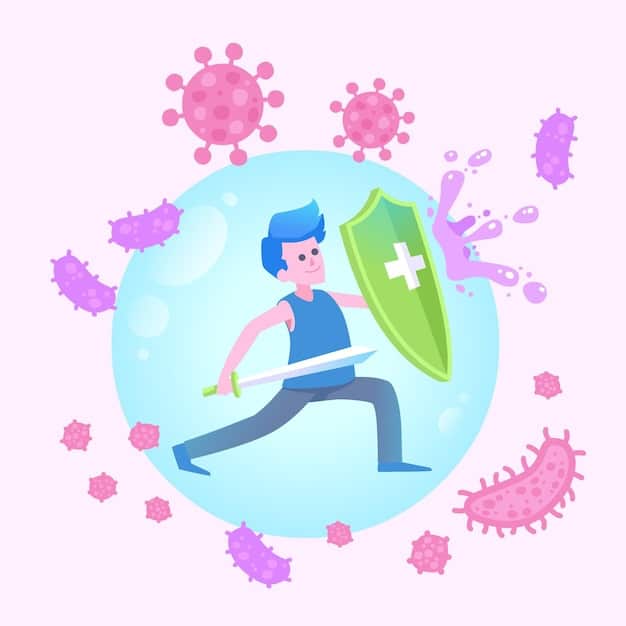The Ultimate Guide: Introducing Allergens to Your Baby (2025 Update)

The Ultimate Guide to Introducing Allergens to Your Baby (Updated for 2025) provides parents with a comprehensive, step-by-step approach to safely introduce common allergenic foods, reducing the risk of future allergies and promoting healthy eating habits from an early age.
Navigating the world of infant feeding can feel overwhelming, especially when it comes to allergies. This The Ultimate Guide to Introducing Allergens to Your Baby (Updated for 2025) provides a clear, evidence-based roadmap to help you confidently introduce allergenic foods to your little one, minimizing risks and setting them up for a lifetime of healthy eating.
Understanding Allergies and Your Baby
Food allergies in babies are a growing concern for many parents. Understanding what allergies are and how they develop is the first step in taking proactive measures to protect your child.
Let’s delve deeper into what causes allergies and why early introduction of allergens is now considered a key preventative strategy.
What are Food Allergies?
A food allergy is an immune system reaction that occurs when your body mistakenly identifies a food protein as a harmful invader. When exposed to that protein, the immune system releases chemicals like histamine, causing allergic symptoms.
These symptoms can range from mild (hives, itching) to severe (difficulty breathing, anaphylaxis).
Why are Allergies on the Rise?
Several theories attempt to explain the increasing prevalence of food allergies. One prominent idea is the “hygiene hypothesis,” which suggests that reduced exposure to microbes in early childhood may weaken the immune system and make it more prone to allergic reactions.
Another factor is the delayed introduction of allergenic foods. For years, parents were advised to avoid these foods until later in infancy, but research now suggests early introduction is more beneficial.
- Hygiene Hypothesis: Limited microbial exposure impacts immune development.
- Delayed Introduction: Waiting too long to introduce allergens.
- Genetics: Family history plays a significant role.
Understanding these factors can help parents make informed decisions about their baby’s diet and allergen introduction.

In conclusion, food allergies are complex, but understanding the basics empowers parents to take proactive steps in their baby’s feeding journey.
When to Start Introducing Allergens
Knowing when to start introducing allergens is almost as important as knowing how. Current guidelines offer clear recommendations based on your baby’s developmental readiness.
Waiting for the right developmental milestones ensures that your baby is physically and neurologically prepared for the introduction of solid foods, including potential allergens.
Developmental Readiness
Before introducing any solid foods, including allergens, ensure your baby shows signs of developmental readiness. These signs typically appear around 6 months of age but can vary from baby to baby.
Look for these key indicators:
Sitting Up: Your baby can sit upright with minimal support.
Head Control: Your baby has good head and neck control.
Interest in Food: Your baby shows interest in what you’re eating, perhaps by reaching for your food or opening their mouth.
Tongue-Thrust Reflex: The tongue-thrust reflex (pushing food out of the mouth) has diminished.
Coordination: Your baby can coordinate their eyes, hands, and mouth to bring food to their mouth.
The “Window of Opportunity”
Research suggests there’s a “window of opportunity” for introducing allergens, typically between 4 and 6 months of age, but ideally when your baby is around 6 months and showing signs of readiness.
Introducing allergens during this period may help train the immune system to tolerate these foods and reduce the risk of developing allergies later in life.
- Around 6 Months: Start when your baby shows signs of readiness.
- Evidence-Based: Research supports the early introduction window.
- Consult Pediatrician: Always discuss with your baby’s doctor.
Knowing these milestones and the appropriate timing can provide the confidence in introducing allergenic foods.
In summary, developmental readiness and the optimal window of opportunity are crucial factors in determining when to start introducing allergens to your baby. Combining these considerations with personalized pediatric advice paves the way for a smoother, safer introduction process.
Top 9 Allergens to Introduce
While many foods can potentially trigger allergic reactions, a specific set of nine allergens are considered most common. Familiarizing yourself with these top allergens is essential for planning your baby’s feeding journey.
These nine allergens account for the majority of food allergies and therefore warrant extra attention when introducing solids.
The Big Nine
The “Big Nine” allergens are responsible for approximately 90% of food allergies. These include:
Cow’s Milk: Found in dairy products like yogurt, cheese, and milk.
Eggs: Present in baked goods, custards, and omelets.
Peanuts: Found in peanut butter, snacks, and some sauces.
Tree Nuts: Includes almonds, walnuts, cashews, and pecans.
Soy: Present in tofu, soy milk, and some processed foods.
Wheat: Found in bread, pasta, and cereals.
Fish: Common examples include salmon, tuna, and cod.
Shellfish: Includes shrimp, crab, and lobster.
Sesame: Increasingly recognized as a significant allergen.
Introducing these allergens one at a time ensures any reactions can be easily identified.
- Cow’s Milk, Eggs, Peanuts: Most common allergens.
- Fish, Shellfish, Sesame: Important to include early.
- Introduce Separately: Monitor for reactions.
In summary, being aware of these top nine allergens will better prepare mothers to plan and execute balanced diets.
How to Introduce Allergens Safely
Introducing allergens safely requires a strategic approach and careful observation. Following established guidelines can help minimize the risk of allergic reactions and make the process more manageable.
Safe allergen introduction involves taking measured steps, monitoring your baby closely, and knowing what to do in case of a reaction.
The Step-by-Step Approach
Follow these steps to introduce allergens safely:
Start with Small Amounts: Begin with a tiny amount of the allergen (e.g., a pea-sized dab of peanut butter).
Introduce One at a Time: Wait 2-3 days before introducing another new allergen.
Monitor for Reactions: Watch for any signs of allergic reaction, such as hives, rash, vomiting, or difficulty breathing. Introduce allergens during the day so you can monitor your baby. Avoid introducing them right before bedtime.
Gradually Increase Quantity: If there’s no reaction, gradually increase the amount of the allergen over the next few days.
Continue Regular Exposure: Once an allergen is successfully introduced, continue to include it in your baby’s diet regularly (e.g., 2-3 times per week) to maintain tolerance.
What to Do if a Reaction Occurs
If your baby shows signs of an allergic reaction, take the following steps:
Mild Reactions: For mild symptoms like a few hives or mild itching, stop feeding the allergen and monitor your baby closely. Antihistamines (like Benadryl) may be helpful after speaking with your pediatrician.
Severe Reactions: For severe symptoms like difficulty breathing, swelling of the face or tongue, or vomiting, call emergency services (911 in the US) immediately.
- Small Amounts: Start with a small test dose.
- One at a Time: Introduce allergens individually.
- Regular Exposure: Maintain tolerance with consistent feeding.
In summary, following these established protocols of small, singular introductions is critical to the success of a mothers balanced diet.
Recipes and Meal Ideas
Incorporating allergens into your baby’s diet doesn’t have to be complicated. There are many easy and delicious ways to include these foods in their meals.
Creative meal planning can make allergen introduction fun and enjoyable for both you and your little one.
Easy Allergen-Friendly Recipes
Peanut Butter Yogurt: Mix a small amount of smooth peanut butter (make sure it has no added salt or sugar) into plain yogurt.
Egg Yolk Puree: Hard-boil an egg, remove the yolk, and mash it with breast milk or formula.
Tofu Scramble: Crumble soft tofu and sauté it with a little bit of olive oil. Serve it as finger food or mix it into a puree.
Fish Flakes: Cook salmon or another fatty fish until it’s flaky. Remove any bones and mix the flakes into a vegetable puree.
Tips for Making it Fun
Presentation Matters: Make the food visually appealing by arranging it in fun shapes or using colorful plates and bowls.
Involve Your Baby: Let your baby touch, smell, and play with the food. Even if they don’t eat much at first, this exposure can help them become more comfortable with new flavors and textures.
- Variety is Key: Offer a diverse range of allergenic foods.
- Make it Fun: Use colorful presentations and involve your baby.
- Simple Recipes: Start with easy-to-prepare options.
In summary, combining creative recipes with engaging presentation tips maximizes the ability of introducing allergens.
Addressing Common Concerns
Many parents have questions and concerns about introducing allergens. Addressing these common worries can empower you to approach the process with confidence.
Being informed about the facts allows you to make decisions based on real evidence, rather than misconceptions or fears.
“My Baby Has Eczema. Should I Delay Allergen Introduction?”
In the past, it was recommended to delay allergen introduction for babies with eczema. However, current guidelines suggest that early introduction is still beneficial, but with extra caution.
Talk to your pediatrician or allergist for personalized recommendations. They may advise you to introduce allergens under medical supervision or to perform allergy testing first.
“My Family Has a History of Allergies. Is My Baby at Higher Risk?”
Yes, babies with a family history of allergies (parents or siblings) are at a higher risk of developing allergies themselves. However, this doesn’t mean you should avoid introducing allergens.
Early introduction is still recommended, but with increased vigilance. Discuss your family history with your pediatrician, who may recommend allergy testing or a more cautious introduction approach.
In summary, addressing such common concerns allows mothers to be successful in their baby diets.
- Eczema: Consult with a specialist.
- Family History: Introduce allergens with increased caution.
- Trust Your Instincts: If you’re concerned, seek medical advice.
| Key Point | Brief Description |
|---|---|
| 👶 Readiness Signs | Look for signs like sitting up and showing interest in food. |
| 🥜 Top Allergens | Focus on the “Big Nine”: milk, eggs, peanuts, tree nuts, soy, wheat, fish, shellfish, and sesame. |
| 🥄 Gradual Intro | Introduce small amounts of one allergen at a time. |
| 🩺 Consult Pediatrician | Always discuss allergen introduction with your pediatrician. |
Frequently Asked Questions
▼
You should typically start introducing allergens around 6 months of age when your baby shows signs of readiness to consume solid foods. Always consult with your pediatrician to determine the best timing for your baby.
▼
Start with a very small amount, such as a pea-sized dab of peanut butter. Monitor your baby closely for any signs of an allergic reaction over the next few hours. Gradually increase the quantity if no reaction occurs.
▼
It’s recommended to introduce allergens one at a time, waiting 2-3 days before introducing another new allergen. This method makes it easier to identify which food caused any reaction if one occurs.
▼
Signs of an allergic reaction can include hives, rash, itching, swelling (especially of the face, lips, or tongue), vomiting, diarrhea, coughing, wheezing, or difficulty breathing. Severe reactions require immediate medical attention.
▼
For mild reactions, such as a few hives, stop feeding the allergen and monitor your baby closely. For severe reactions like difficulty breathing, swelling, or vomiting, call emergency services (911 in the US) immediately.
Conclusion
Introducing allergens to your baby can be a straightforward journey when armed with the right information and approach. By following these guidelines, consulting with your pediatrician, and staying informed, you can help your baby develop a healthy and varied diet, minimizing the risk of food allergies and setting them up for a lifetime of good health.





